Sierras de Córdoba
The Sierras de Córdoba is a mountain range in central Argentina, located between the Pampas to the east and south, the Chaco to the north and the foothills of the Andes to the west. Almost the entire range, except for the southwestern margin in San Luis Province, is located in Córdoba Province.
_2008-09-20.jpg)
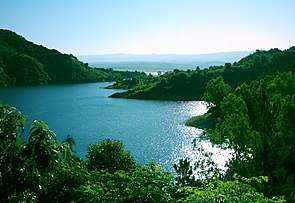
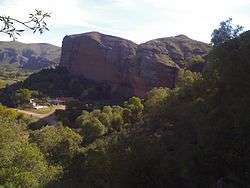
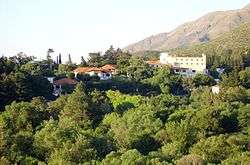
Origin and topography
Much older than the Andes, having been formed in the Paleozoic and extensively eroded, the Sierra de Córdoba still manages to reach a height of 2880 metres at Mount Champaquí, east of Villa Dolores. The northern part, known as the Sierra de Norte, is considerably lower and less rugged. The mountains, when first built, formed the boundary between Gondwana and the then-expanding Pacific Ocean. They consist chiefly of metamorphic rocks such as quartzite, which were formed when large quantities of marine sediment were subject to enormous heat and pressure. In the Ordovician, there was extremely intense volcanism over the region, almost all of which is now completely eroded, forming the many salt lakes on the western side of the range, which is an elevated plateau leading to the foothills of the Andes.
The Sierras de Córdoba where the effects of the ancient Pampean orogeny can be observed, owes it modern uplift and relief to the Andean orogeny in the Tertiary.[1]
The range has a largely rounded contour, and there are few major valleys. Salt lakes (salinas), the largest of which is Salinas Grandes, receive most runoff from the mountains, except for the eastern part which drains into swamps in the Pampas. Though regarded as part of the Paraná River basin, under present climatic conditions almost no water reaches the river even in wet years.
Climate
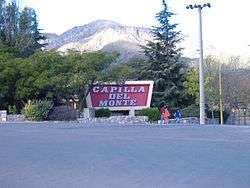
At lower altitudes, the Sierra de Córdoba has a warm temperate climate (Köppen Cwa), with hot, wet summers with frequent thunderstorms and mild, dry winters. Average annual rainfall at Córdoba is about 715 mm (28 inches) but is highly variable. On the eastern side of the Sierra, rainfall can be as high as 1200 mm (47 inches) per year, but it quickly drops off on the western side to less than 400 millimetres (16 inches). Maximum temperatures at low elevations are high, ranging from 33 °C (92 °F) in summer to 16 °C (60 °F) in winter, but at an altitude of 2000 metres, temperatures are about 14 °C (25 °F) cooler and exposure is very high. However, because the winters are so dry, very little snow falls even at the highest altitudes and there is no evidence of glacial or periglacial features from the Pleistocene.
The cooler climate in the mountains has encouraged development of many summer resorts for the wealthy of Córdoba, notably Alta Gracia and Jesús María.
Vegetation
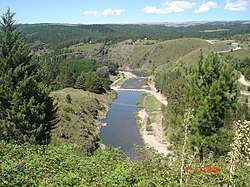
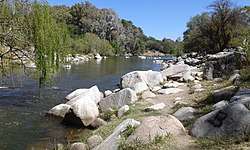
.
The flora of the Sierra de Córdoba is related to that of the Chaco region (see Gran Chaco for details) and consists at low altitudes of forest dominated by Lithrea ternifolia and Fagara coco, with Schinopsis haenkeana dominant on the dry western slopes. High exposure causes the limits of tree growth to be quite low at about 2000 metres, above which an extensive alpine grassland dominated by various species of Stipa predominates. Many of the species in this alpine zone are very rare, but the level of conservation is not high, with most of the mountain range unprotected. More than 100 bird species are common in the mountains, but ranching has reduced most native mammal populations severely.
It is believed that the vegetation of the Sierra de Córdoba has varied greatly over the Quaternary, with some periods in the Holocene between 8000 and 500 years before today when forests extended to the now-dry western side of the mountain range and the adjacent Sierra de San Luis. At other times, such as glacial periods and the earliest part of the Holocene, the whole mountain range was completely treeless due to extremely low rainfall. This may explain why few endemics are found outside the zone above the timberline — where species that have inhabited the area for thousands of years take a kind of refuge from a warmer, wetter climate.
People
Most of the population of the region lives in Córdoba city, which contains about half the provincial population — with most of the rest in the Pampas region well east of the range. The lack of arable land means that few people live in the mountains themselves, where the major industries are grazing and tourism.
Tourism
The Sierras de Córdoba is one of the most important holiday centers of Argentina. Three million tourists visit the Sierras annually. The most important tourist destinations are Villa Carlos Paz, Cosquín, La Falda, Alta Gracia, and Villa General Belgrano amongst others.
Wineries
Two areas were large producers of wine in the past: Colonia Caroya in the north, and Villa Dolores in the west. These areas traditionally focused on cheaper, sweet wines for domestic consumption. In recent years, sophisticated wine-making has begun taking place, both in these 'traditional' locations, as well as in exciting terroirs in the eastern side of the mountains, around Villa General Belgrano and La Cumbrecita. The area has a cooler climate, with some (light) snowfall in the winter, and a number of boutique wineries have experimented with different grape types and techniques, sometimes with exceptional results (Familia Navarro Torre recently was awarded a gold medal in the Vinandino competition with a Cabernet-Malbec from 2009). The region is otherwise known for its craft beers because of the large German Argentine community established there.
References
- Rapela, C.W.; Pankhurst, R.J; Casquet, C.; Baldo, E.; Saavedra, J.; Galindo, C.; Fanning, C.M. (1998). "The Pampean Orogeny of the southern proto-Andes: Cambrian continental collision in the Sierras de Córdoba" (PDF). In Pankhurst, R.J; Rapela, C.W. (eds.). The Proto-Andean Margin of Gondwana. 142. Geological Society, London, Special Publications. pp. 181–217. Retrieved 7 December 2015.
- Whitmeyer, Steven J. and Simpson, Carol; Regional deformation of the Sierra de San Luis, Argentina: Implications for the Paleozoic development of western Gondwana; Tectonics, Vol. 23, TC1005, doi:10.1029/2003TC001542, 2004.
External links
- Región Traslasierra
- "Cordoba montane savanna". Terrestrial Ecoregions. World Wildlife Fund.